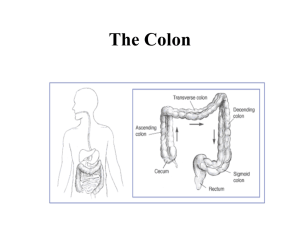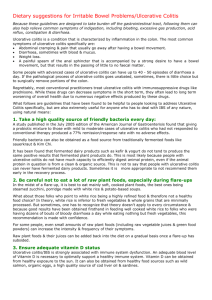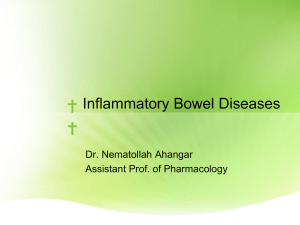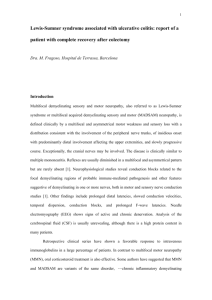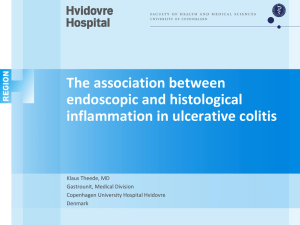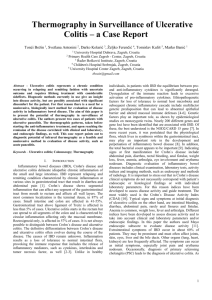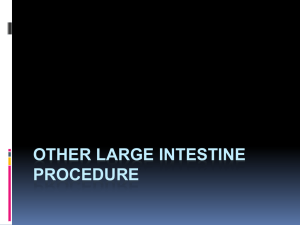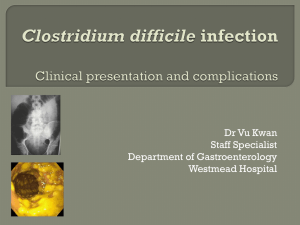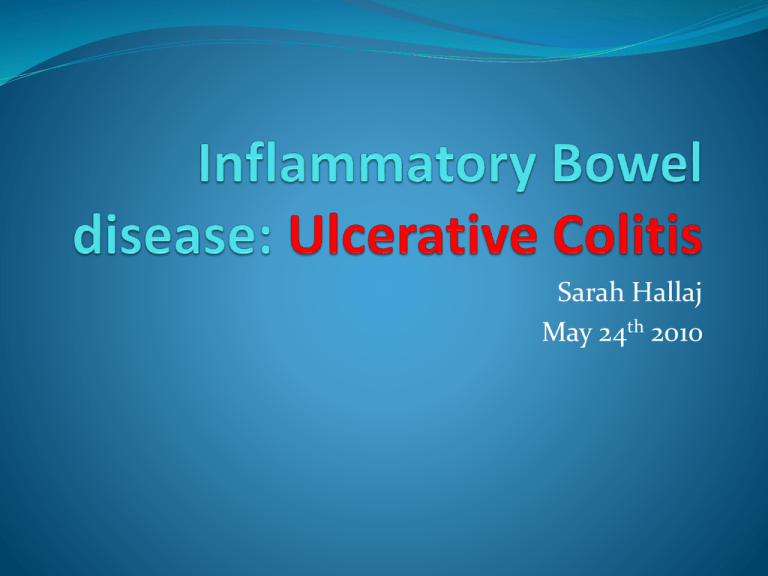
Sarah Hallaj
May 24th 2010
Outline
Present my patient
Nutrition assessment
Tests
Ulcerative colitis
Trivia questions
Nutrition focused physical examination: PICTURES!
Nutrition intervention, monitoring & evaluation
Nutrition Assessment
Client history
Social history: 28 year old white male who migrated
from Ukraine, Eastern Europe with the rest of his
family. He was a carpenter but is now unemployed
with no insurance. He lives with his 2 sisters who
usually do the cooking at home. His parents and
brother were present at his hospital stay.
Admit date: 2/3/2010
Chief complaint:
Diarrhea ( hematochezia: bloody soft stools) & weight
loss of 23kg in 2 ½ months
Initial diagnosis:
Anal fissure & cachexia
Outpatient gastroenterology
consultation
Patient became ill in November 2009 with slow
progressive worsening of his symptoms
Patient was having over 15 bowel movements a day,
sometimes awakening him from sleep at night
He noted his inability to eat and eventually lost 23 kg
Stool studies were negative for any enteric pathogens,
C. Diff, and Giardia antigen
Endoscopic evaluation was consulted but refused
because of financial concerns and anxiety about
consequences of the test
Medication list in November 2009
Mesalamine : anti-inflammatory (for ulcerative colitis
or Cronh’s disease), oral
Rowasa enemas: anti-inflammatory (for ulcerative
colitis or Cronh’s disease), rectal
Prednisone (corticosteroids): anti-inflammatory,
immunosuppressant
Loperamide: anti-diarrheal
Sulfasalazine: treats RA or rectal bleeding and diarrhea
from ulcerative colitis
Anthropometric measurements
Height: 6ft 0in
Weight: 48.44 kg
BMI: 14.5
IBW: 72.3 kg
% IBW: 67 %
Weight history: 72 kg in November 2009
33 % of weight loss in 2 ½ months
ICD-9 code
Malnutrition coding reference from
Providence Health & Service
ICD-9 Code: Other severe, protein-calorie
malnutrition:
Criteria
Currently at:
Weight < 85%
67% of IBW
Severe weight loss >7.5% in 3
months
33 % weight loss in 2 ½ months
Depressed visceral protein
stores
Albumin 2.4 mg/dL
Prealbumin 11 mg/dL
Signs of muscle wasting
Arms, legs, chest, and temples
Underweight, BMI <19
BMI: 14.5
Food/nutrition-related history
Prior to Nov. 09 patient was consuming over 2500
kcal/day
Prior to hospitalization patient would consume mom’s
cooked meals 5-6 small meals ~ 1300-1400 kcal/day
Due to inadequate oral intake, added ensure
supplement and started patient on calorie count
Estimated Energy requirements
Using the Mifflin equation: 1650 kcal (34 kcal/kg)
Added 200 kcal for weight gain
Total = 1850 kcal/day (38 kcal/kg)
Protein requirements=58.1- 72.7 g/day (1.2-1.5 g/kg )
Biochemical data
Days
PO4
K+
Mg
Day 2
2/4/10
Albumi
n
Prealbu
min
Hemogl Weight
obin
(kg)
2.4
11.0
10
48.44
Day 3
2/5/10
2.2
WNL
WNL
49.2
Day 5
2/7/10
WNL
WNL
WNL
50.00
Day 6
2/8/10
3.6
4.2
1.8
Day 8
d/c
2/10/10
3.2
4.3
2.3
Referen PO4
K+
ce
mg/dL mmol/
range
L
2.3-4.7
3.7-5.5
2.4
11.0
10.6
Mg
Album
mg/dL in
mg/dL
Prealbumin
mg/dL
Hemoglobin
gm/dL
1.7-2.5
18-32
13.2-16.2
3.2-4.9
Calorie count
Hospital day 2: 844 kcal/day & 27 gm Pro
Hospital day 3: 2947 kcal & 116 gm Pro
Hospital day 4: 2872 kcal & 117 gm Pro
Hospital day 5: 3000 kcal & 97 gm Pro
Current diet order: General
Refeeding syndrome
Is defined as: severe electrolyte and fluid shifts
associated with metabolic abnormalities in
malnourished patients refeeding either orally,
parentally or enterally.
Due to patient’s low phosphorus, he was at risk of
refeeding syndrome
Tests:
Sigmoidoscopy
Magnetic Resonance Elastography (MRE)
Chest x-ray: normal
Human immunodeficieny virus (HIV): negative
Hepatitis B surface antigen: non-reactive
Stool output: no ova or parasites
Quantiferon gold: false positive (BCG vaccination)
TSH & T4: WNL
Fecal fat test: negative
What is Sigmoidoscopy?
Is when a doctor inserts an endoscope (a long, flexible, lighted tube
connected to a computer and TV monitor) into the anus to see the
inside of the colon and rectum. The doctor will be able to see any
inflammation, bleeding, or ulcers on the colon wall.
What is Magnetic Resonance
Elastography (MRE)?
Phase-contrast-based MRI imaging technique that
can directly visualize and quantitatively measure
propagating acoustic strain waves in tissue-like
materials subjected to harmonic mechanical
excitation.
Produces color-coded images known as elastograms
that indicate tissue elasticity or stiffness.
This is significant because during a physical
examination, palpation can be effective in detecting
tumors, but is restricted to parts of the body that are
not accessible to the physician’s hand.
Results
Sigmoidoscopy showed severely inflamed tissue up
to 40cm and 3 circular punched out ulcers in the
rectum
MRE showed gastric distention & thick-walled
inflamed rectosigmoid colon
MD Diagnosis
Inflammatory bowel disease
Ulcerative colitis
Inflammatory Bowel Disease (IBD)
Is a general name for diseases
that cause inflammation in
the small intestine and colon.
It can be difficult to diagnose
because its symptoms are
similar to other intestinal
disorders.
Two types of IBD include:
ulcerative colitis and Crohn’s
disease
IBD
Ulcerative Colitis
Crohn’s disease
What is ulcerative colitis
Is a disease that causes chronic inflammation and ulcers in
the lining of the rectum and colon. Ulcers form where
inflammation has killed the cells that usually line the
colon, then bleed and produce pus.
Inflammation in the colon also causes the colon to empty
frequently, causing diarrhea and abdominal pain.
When the inflammation occurs in the rectum and lower part
of the colon it is called ulcerative proctitis. If the entire colon
is affected it is called pancolitis. If only the left side of the
colon is affected it is called left-sided or distal colitis.
Symptoms of ulcerative colitis
Anemia
Fatigue
Weight loss
Loss of appetite
Rectal bleeding
Loss of body fluids and nutrient => diarrhea
Skin lesions
Joint pain
Growth failure (esp. in children)
Ulcerative colitis complications:
Toxic megacolon: life-threatening complication
Cancer
If all fails…
Surgery to remove part or all of the colon
Removing the entire colon cures ulcerative colitis
Ileal Pouch-Anal Anastomosis
(IPAA):
• Allows the patient to have normal bowel movements
http://www.mayoclinic.org/colostomy-sparing-surgery/ipaa.html
IPAA cont’d
IPAA might not be appropriate for each patient
It depends on the severity of the disease & the patient’s
needs, expectations and lifestyle
QUESTIONS
Who is affected by ulcerative
colitis?
Who is affected by ulcerative
colitis?
It can occur in people of any age, but usually starts
between the ages of 15 and 30, and less frequently
between 50 and 70 years of age.
It affects men and women equally and appears to run in
families.
A higher incidence of ulcerative colitis is seen in
Whites and people of Jewish descent.
True or false?
Ulcerative colitis is caused by emotional distress
and/or sensitivity of certain food products
Nutrition Diagnosis
PES Statements
Inadequate protein-energy intake related to altered GI
function as evidenced by altered nutrition-related lab
values: albumin 2.4 mg/dL, hemoglobin 10 gm/dL and
bloody diarrhea
Malnutrition related to involuntary weight loss as
evidenced by 33% weight loss in 2 ½ months & 67%
IBW
Nutrition-focused physical findings
Physical appearance
Muscle and fat wasting: temple, chest and extremities
Nutrition Intervention
Placed calorie count order
Added ensure supplement
Nutrition education: educated patient on low residue
diet per MD order and provided handout from
American Dietetic Association
Coordination of nutrition care: talked with nurses to
assure daily weights
Answered patient’s questions
ADA Low residue diet:
Recommended foods:
Yogurt, cheese, soy milk, rice milk, or almond milk
Tender, ground, & well cooked beef & other protein
foods (tofu, fish, eggs, smooth nut butters)
Refined white grains
Well-cooked vegetables
Peeled fruits & fruit juices w/out pulp
EAL recommends:
Consuming a diet with > 15 g/day of fermentable fiber
resulted in improvements in ulcerative colitis
Nutrition Monitoring &
Evaluation
Completed follow-ups
Monitored electrolytes
Evaluated patient’s diet adequacy & POC
Discharge medication list:
Ciprofloxacin: antibiotic
Prednisone (30 mgx2/day): anti-inflammatory,
immunosuppressant
Ferrous sulfate (325 mg) w/ vitamin C: treats ironanemia deficiency
Remicade (infliximab/etanercept): anti-arthritic,
Crohn’s disease/ ulcerative colitis treatment
What nutrition interventions would you
suggest to address nutrition issues caused
by long term use of prednisone?
Suggest including a calcium with vitamin D
supplement
References
Refeeding Syndrome- Awareness, Prevention and Management 1:4 (2009): 1495-498. Head and Neck
Oncology. BioMed Central, 26 Jan. 2009. Web. 15 May 2010.
<http://www.headandneckoncology.org/content/pdf/1758-3284-1-4.pdf>.
Ulcerative Colitis. National Institute of Health, Feb. 2006. Web. 15 May 2010.
<http://digestive.niddk.nih.gov/ddiseases/pubs/colitis/>.
Medical Imaging Analysis 5.4 (2001): 237-54. Science Direct. Web. 15 May 2010.
<http://www.sciencedirect.com/science?_ob=ArticleURL&_udi=B6W6Y-44HXCK23&_user=10&_coverDate=12%2F31%2F2001&_rdoc=1&_fmt=high&_orig=search&_sort=d&_docanchor
=&view=c&_searchStrId=1336406594&_rerunOrigin=scholar.google&_acct=C000050221&_version=1&
_urlVersion=0&_userid=10&md5=473bd5ffa89813a929eab07fafdb2ad0>.
CANNOM, REBECCA R., et al. "Inflammatory Bowel Disease in the United States from 1998 to 2005:
Has Infliximab Affected Surgical Rates?." American Surgeon 75.10 (2009): 976-980. Academic Search
Premier. EBSCO. Web. 17 May 2010.
http://proxy.library.oregonstate.edu/login?url=http://search.ebscohost.com/login.aspx?direct=true&
db=aph&AN=44682704&loginpage=Login.asp&site=ehost-live.
Eat Right. American Dietetic Association, 1 July 2008. Web. 21 May 2010.
<http://www.adaevidencelibrary.com/conclusion.cfm?conclusion_statement_id=250903>.
Food Medication Interactions. 15th ed. Birchrunville: Food-Medication Interactions, 2008. Print.
International Dietetics and Nutrition Terminology Reference Manual. 2nd ed. Chicago: American
Dietetic Association, 2009. Web. 16 May. 2010.
<https://ozone.ohsu.edu/foodandnutritionservices/references/idnt_second_edition.pdf>.




